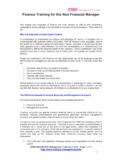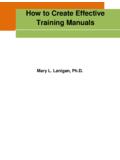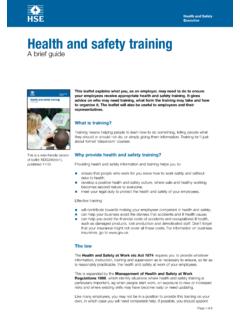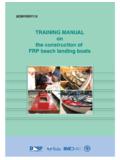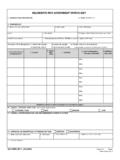Transcription of BASIC FIRE ALARM TRAINING - ltfd.org
1 BASIC fire ALARM TRAINING Per the defini+on in NFPA 72 A system or por+on of a combina+on system that consists of components and circuits arranged to monitor and annunciate the status of fire ALARM or supervisory signal- ini+a+ng devices and to ini+ate the appropriate response to those signals What is a fire ALARM system? BASIC Components of a fire ALARM System Control Panel Communica+ons Ini+a+ng Devices No+fica+on Appliances Control Panel/Communicator A component of the fire ALARM system that receives signals from ini+a+ng devices and processes these signals to determine the fire ALARM output func+ons Communica+ons DACS Digital ALARM Communica+ons Systems POTS (Plain Old Telephone System) Loop Start with line seizure from the point of demarca+on prior to sending it to the home or business.
2 Cable Company Service assuming you have no CODEC, Voice Compression or back up power issues. One Way/Two Way Radio Mesh Radio and GSM IP Communicators with UL lis+ngs Sole Path Communicators with UL Lis+ngs 2010 Edi+on Na+onal fire ALARM and Signaling Code NFPA 72- 2010 Housecleaning Efforts Recently removed transmission methods AcBve MulBplex McCulloh Directly Connected Non- Coded Systems Private Microwave Radio Systems ANNUNCIATOR Ini+a+ng Devices A system component that originates transmission of a change- of- state condi+on Examples of Ini+a+on Devices Smoke Detector Heat Detector Automa+c Ini+a+ng Devices Duct Detectors Pull Sta+on Manual Ini+a+ng Devices Types Of Sprinkler Systems Wet Pipe: Since water is always present in the pipes supplying the sprinkler heads, these types of sprinkler system are quick to react upon the opera+on of a sprinkler head in a fire scenario.
3 These are the most common systems and are used in buildings where there is no risk of freezing. Wet systems are required for mul+- storey or high- rise buildings and for life safety systems for UK standards. Dry pipe: The pipes are filled with air under pressure at all +mes and the water is held back by the control valve outside of the protected area. Should a sprinkler head open in a fire scenario, the drop in air pressure opens the valve and water flows into the pipe work and onto the fire . Dry pipe systems are used where wet or alternate systems cannot be used. Alternate: Alternate systems have the pipes full of water for the summer period, then subsequently drained down and filled with air for the winter.
4 This is typically for buildings that are not heated, underground car parks. Water Flow Valve Tamper Sprinkler System Devices Sprinkler Heads A fire ALARM system component such as a bell, horn, speaker, light, or text display that provides audible, tac+le, or visible outputs, or any combina+on thereof No+fica+on Appliances Examples of No+fica+on Appliances Horn/Strobe Strobe- Ceiling Mount) Speaker Bell fire ALARM Requirements In Pennsylvania, Ohio, and many other states, the Interna+onal Building Code (IBC) is the model building code for the state. Each building, based on it s use, is assigned a Use and Occupancy Code The Use and Occupancy Code then determines if a fire ALARM system is required. fire ALARM systems may also be required by other authori+es, such as insurance companies Interna+onal Building Code Once it is determined that a fire ALARM system will be installed, NFPA 72 then tells us how to install the system NFPA 72 The Na+onal fire ALARM Code Once it is determined that a fire ALARM is required by the IBC, and has been designed per NFPA 72, the Na+onal Electric Code (NEC) tells us how to wire the system NFPA 70 The Na+onal Electric Code Underwriter s Laboratories (UL)
5 UL is a global independent safety science company with more than a century of exper+se innova+ng safety solu+ons from the public adop+on of electricity to new breakthroughs in sustainability, renewable energy and nanotechnology. Dedicated to promo+ng safe living and working environments, UL helps safeguard people, products and places in important ways, facilita+ng trade and providing peace of mind. What is UL? Basically, UL is a company that has developed standards on how products should operate safely. Manufacturers send their products to UL to be tested by UL to UL standards. If the product passes the tests, the manufacturer can place the UL mark on the product. Huh? fire ALARM service companies and monitoring centers apply to UL to become listed companies UL inves+gates the company and ensures the company understands and can comply with applicable standards UL audits listed companies once per year to ensure the company is maintaining compliance What about fire alarms and UL?
6 Authori+es Having Jurisdic+on (AHJ) will require a UL cer+ficate on a system The UL Cer+ficate is the UL mark for fire ALARM systems The UL cer+ficate on a fire ALARM system ensures the AHJ that the system was designed, installed, tested and maintained properly One of the main reasons an AHJ will require a UL cer+ficate is to reduce false alarms FM basically provides the same service as UL. At one +me, when a property was insured by Factory Mutual insurance, they required the fire ALARM system to be FM approved. Factory Mutual (FM) fire ALARM system ALARM transmissions require immediate dispatch of the fire department (unless otherwise required) Commercial fire ALARM Monitoring and Dispatching Requirements Runner response is required on all UL Listed/FM Placard fire ALARM systems.
7 Central Sta+on is responsible for the dispatch of Runners in accordance with procedures based on NFPA 72 aaer normal business hours. During normal business hours, Customer Care/Service is responsible. Runner Service is defined as a service performed at the protected premises, including resebng and silencing of all equipment transmibng fire ALARM or supervisory signals to an off- premises loca+on. A UL Runner is a person (other than the required number of operators on duty at central, supervising, or runner sta+ons) available for prompt dispatching, when necessary, to the protected premises. A Runner shall not be required if there will not be a fire department or customer representa+ve on- site. UL Runner Response Dispatch runner or technician to the protected premises within 1 hour of receipt of a signal if the equipment needs to be manually reset by the prime contractor.
8 A runner/technician response may be waived by the fire department or other Authority Having Jurisdic+on (AHJ). The customer may not call off a runner response. A runner/technician is not required if the signal results from a prearranged test. If a runner/technician is required, they must arrive within 1 hour of the signal being received. fire ALARM Response Dispatch a runner or maintenance person to arrive within 1 hour of the signal being received to inves+gate. Central sta+on must dispatch a runner/maintenance person to the protected premises if a supervisory signal is received, even if the signal has reset. A runner/technician is not required if the signal results from a prearranged test. In addi+on, a runner would not be required if a prearranged procedure is in place with the subscriber on the handling of supervisory signal and the subscriber is able to reset the supervisory signal.
9 If the subscriber is unable to reset the supervisory signal, a runner/technician must s+ll arrive within 1 hour of receipt of the signal. Supervisory alarms are defined as alarms received from sprinkler system supervisory appliances. These include, but are not limited to, valve tampers switches, low air pressure/temperature switches, fire pump supervision, tank level/temperature switches. Addi+onally, when duct detectors are configured not to provide fire ALARM response, they shall be considered a supervisory signal Supervisory Signal Response Dispatch personnel to arrive within 4 hours to ini+ate maintenance, if necessary. This is interpreted to mean the central sta+on must dispatch a technician to the protected premises if a trouble signal is received.
10 If a reset signal to the trouble signal is received before the technician arrives, the technician would not have to respond. The customer should be no+fied of the reset signal and asked if they s+ll require runner response. Trouble signals also include such signals as AC power loss, badery trouble, phone line trouble, failure to test, and other related control panel problem signals. If the trouble is due to a known cause that would not be able to be repaired by the technician, runner response is not required ( AC power to the building is off due to storm damage). Trouble Signal Response The UL Runner should complete a Select Security Service Ticket and clearly mark the +cket as a UL Runner so that the customer is charged accordingly.
